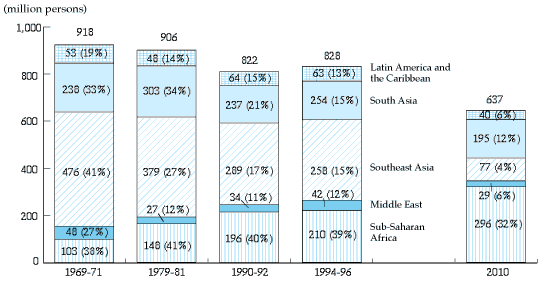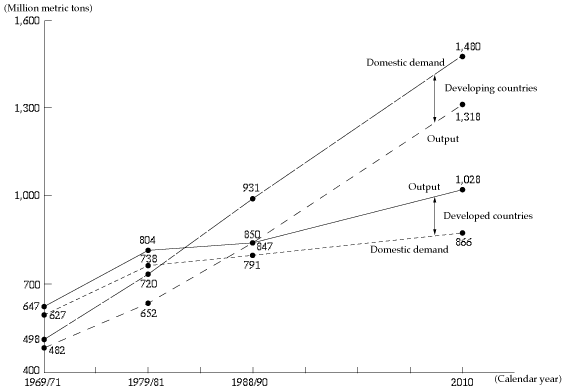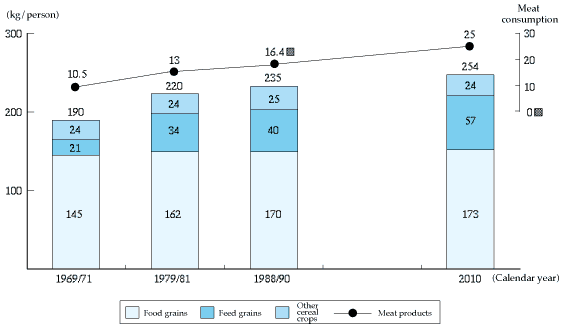Official Development Assistance (ODA)
Part III. Sectoral Issues for ODA
Chapter 3 Responding to the Fight against Hunger: Food and Agricultural Cooperation
Today, over 800 million people worldwide (14 percent of the global population and 18 percent of the population in the developing world) suffer from malnutrition and hunger. Many developing countries have not been able to produce enough food to keep pace with explosive trends in population growth, and also face difficulty in importing food commodities due to a shortage of foreign exchange. In some countries, rapid economic growth has been accompanied by an uptrend in the consumption of meat products and other changes in dietary structure, thereby spurring more demand for feed grain and putting the food supply under heavier strain.
Given the various environmental constraints, meeting this upsurge in food demand by placing more land into cultivation is not a realistic option. Furthermore, topsoil erosion, scarce water resources, climactic fluctuations, and abnormal weather patterns have also compounded the challenge of securing a stable food supply for the global population. Alleviating malnutrition in the developing world counts as the humanitarian dimension of the drive to deal with the food problem. However, it has become an issue of global scale in that it also affects the industrialized countries.
The economic infrastructure in most developing countries is focused mainly on agriculture, forestry, and fisheries. Aid in food output, agriculture, and rural development will be crucial to sustainable economic growth in these countries. The challenge in this context is to provide aid through comprehensive programs of agricultural development in order to achieve environmentally sound agricultural systems that are capable of sustainable output.
Chart 27 Demographics of Malnutrition in the Developing World

- Source:
- "Document for the 115th Session of the Council," "World Agriculture : Towards 2010" (1995) Food and Agriculture Organization.
- Notes:
- 1. Comparisons of 2010 and other years are not possible because the statistics were derived from multiple sources.
- 2. Figures in parentheses are shares of the total population in each region.
- 3. Figures for the Middle East were based on data for Egypt, Libya, Tunisia, Algeria, Morocco, and Sudan.
Chart 28 Trends in Grain Supply and Demand

- Source:
- "World Agriculture : Towards 2010" (1995) Food and Agriculture Organization.
Section 1 Changes in the Philosophical Basis for Food Aid and Agricultural Aid: Products of the World Food Summit (the Quest for Human-Centered Development and Participatory Development)
For many years, it was optimistically anticipated that strides in economic growth alone would bring about improvements in the standard of living for citizens in developing countries, including gains, food and nutrition. In some countries, however, the initial expectations of economic growth have not been met, whereas in others economic growth has merely aggravated the inequalities among regions and social classes or resulted in environmental devastation. The view, therefore, has gained ground that the emphasis of development should be placed on the satisfaction of basic human needs or the promotion of human-centered development. Furthermore, to improve the effectiveness of aid for these purposes, increasingly greater stress has been placed on the perspectives of participatory development, a concept that stresses the full participation of all segments of the local population in the development process.
Echoing these trends, the World Food Summit in 1996 called on all countries to pursue coordinated actions toward two key goals: world food security and reducing the number of undernourished people to half the present level no later than 2015 (the Rome Declaration). Since 1994, the Food and Agriculture Organization of the United Nations (FAO) has been implementing the Special Programme for Food Security, targeting 86 low income countries troubled by shortages of food. Activities under this program have been implemented in accordance with the fundamental viewpoints of the Rome Declaration. Furthermore, the Development Partnership Strategy17 (put forward in 1996 by the Development Assistance Committee [DAC], a group composed of members in the Organization for Economic Cooperation and Development [OECD]) set specific targets with a direct bearing on the effort to improve human access to food and nutrition, such as a reduction by half in the infant and maternal mortality rates.

